Related Research Articles

A diatom is any member of a large group comprising several genera of algae, specifically microalgae, found in the oceans, waterways and soils of the world. Living diatoms make up a significant portion of the Earth's biomass: they generate about 20 to 50 percent of the oxygen produced on the planet each year, take in over 6.7 billion tonnes of silicon each year from the waters in which they live, and constitute nearly half of the organic material found in the oceans. The shells of dead diatoms can reach as much as a half-mile deep on the ocean floor, and the entire Amazon basin is fertilized annually by 27 million tons of diatom shell dust transported by transatlantic winds from the African Sahara, much of it from the Bodélé Depression, which was once made up of a system of fresh-water lakes.

Lake Matano, also known as Matana, is a tropical lake in East Luwu Regency, South Sulawesi province, Indonesia, that is noteworthy for the unique environment in its deeper layers.

The order Pennales is a traditional subdivision of the heterokont algae known as diatoms. The order is named for the shape of the cell walls of pennate diatoms, which are elongated in valve view. The valves may be linear or oval in shape, and usually bear bilaterally symmetrical ornamental patterns. These patterns are composed of a series of transverse lines that can appear as rows of dots when viewed with an optical microscope. Some pennate diatoms also exhibit a fissure along their longitudinal axis. This is known as a raphe, and is involved in gliding movements made by diatom cells; motile diatoms always possess a raphe.

The Coscinodiscophyceae are a class(s) of diatoms. They are similar to the Centrales, a traditional, paraphyletic subdivision of the heterokont algae known as diatoms. The order is named for the shape of the cell walls of centric diatoms, which are circular or ellipsoid in valve view. The valves often bear radially symmetrical ornamental patterns that can appear as dots when viewed with an optical microscope. Some also bear spines on their valves, which may either increase cell surface area and reduce sinking, or act as a deterrent to zooplankton grazers. Unlike pennate diatoms, centric diatoms never have a raphe.
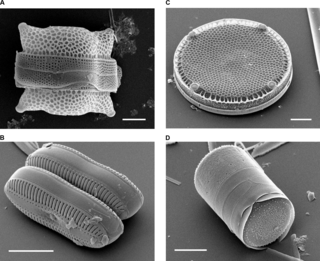
A frustule is the hard and porous cell wall or external layer of diatoms. The frustule is composed almost purely of silica, made from silicic acid, and is coated with a layer of organic substance, which was referred to in the early literature on diatoms as pectin, a fiber most commonly found in cell walls of plants. This layer is actually composed of several types of polysaccharides.
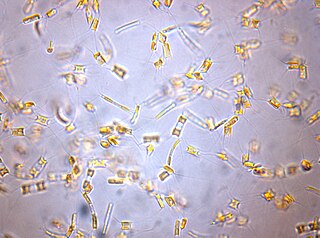
Attheya is a genus of small single celled diatoms. Some of these species were earlier regarded to belong to Chaetoceros, or to Gonioceros, the taxonomic status of some of these species are still debated.

Bacteriastrum is a genus of diatoms in family Chaetocerotaceae. There are more than 30 described species in genus Bacteriastrum, but many of these are not currently accepted, and new species are still added to the genus. The type species for the genus is Bacteriastrum furcatum Shadbolt.
Attheya gaussii is a species of diatoms in the genus Attheya.
Briggera is a genus of diatom known from the fossil record.
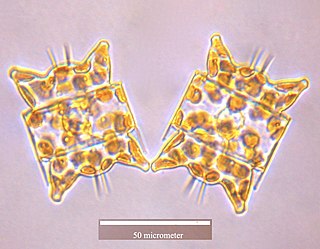
Eupodiscaceae is a diatom family (Bacillariophyceae) present both in marine and freshwater habitats Odontella is the only genera in this family with typical marine species. However, Round et al. (1990) placed Odontella in Triceratiaceae (Schutt) Lemmermann, order Triceratiales Round and Crawford, subclass Biddulphiophycidae Round and Crawford. The taxonomic status of this family is unclear and disputed.

Abas is an extinct genus of diatoms consisting of only one known species: Abas wittii. Originally observed as a fossil genus classified with diatom spore forms under the name Syringidium. Abas was observed to be live from the Eocene to Oligocene epoch appearing in tropical sites.

Surirellales is an order of diatoms.
Cymatosirales is an order of diatoms in the superorder Cymatosirophycanae.
Luticola is a genus of marine diatoms.
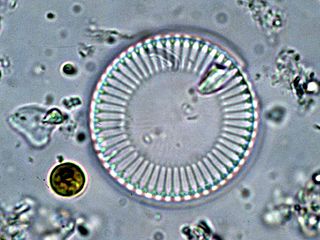
Cyclotella is a genus of diatoms often found in oligotrophic environments, both marine and fresh water. It is in the family Stephanodiscaceae and the order Thalassiosirales. The genus was first discovered in the mid-1800s and since then has become an umbrella genus for nearly 100 different species, the most well-studied and the best known being Cyclotella meneghiniana. Despite being among the most dominant genera in low-productivity environments, it is relatively understudied.

Diatoms belong to a large group called the heterokonts, which include both autotrophs such as golden algae and kelp; and heterotrophs such as water moulds. The classification of heterokonts is still unsettled: they may be designated a division, phylum, kingdom, or something intermediate to those. Consequently, diatoms are ranked anywhere from a class, usually called Diatomophyceae or Bacillariophyceae, to a division (=phylum), usually called Bacillariophyta, with corresponding changes in the ranks of their subgroups.
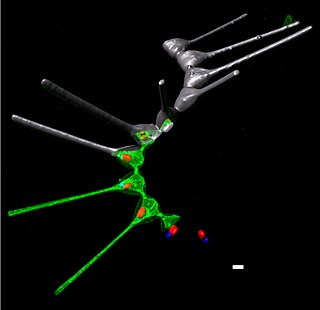
Asterionellopsis is a genus of diatoms belonging to the family Asterionellopsidaceae.
Asteroplanus is a genus of diatoms belonging to the family Asterionellopsidaceae.
Rhizosoleniaceae is a family of diatoms belonging to the order Rhizosoleniales.

Ellerbeckia is a genus of diatoms belonging to the family Paraliaceae.
References
- ↑ Round, F.E.; Crawford, R.M.; Mann, D.G. (1990). "Appendix I: New Taxa §Cymatosirophycidae, F.E Round & R.M. Crawford, subclass. nov.". Diatoms: biology and morphology of the genera. Cambridge University Press. p. 651. ISBN 978-0-521-36318-1.